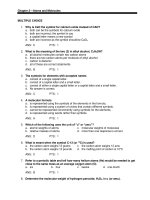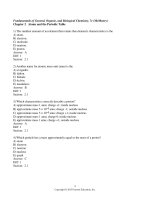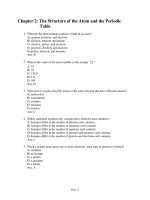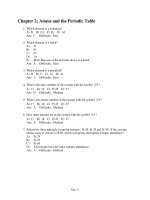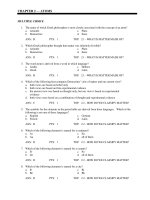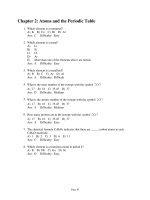General organic and biological chemistry 5e timberlack test bank chapter 2
Bạn đang xem bản rút gọn của tài liệu. Xem và tải ngay bản đầy đủ của tài liệu tại đây (152.27 KB, 21 trang )
General, Organic & Biological Chemistry, 5e (Timberlake)
Chapter 2 Chemistry and Measurements
2.1 Multiple-Choice Questions
1) The metric base unit for length is the
A) meter.
B) inch.
C) millimeter.
D) kilometer.
E) foot.
Answer: A
Objective: 2.1
Global Outcomes: GO2
2) The metric unit for volume is the
A) meter.
B) quart.
C) liter.
D) pint.
E) centimeter.
Answer: C
Objective: 2.1
Global Outcomes: GO2
3) Which of the following is the basic unit of mass in the SI?
A) pound
B) kilogram
C) milligram
D) microgram
E) gram
Answer: B
Objective: 2.1
Global Outcomes: GO2
4) Which of the following is a measurement of mass in the metric system?
A) milliliter
B) centimeter
C) kilogram
D) Celsius
E) meter
Answer: C
Objective: 2.1
Global Outcomes: GO2
1
Copyright © 2016 Pearson Education, Inc.
5) Which of the following is a measurement of temperature in the metric system?
A) oz
B) lb
C) Celsius
D) kilogram
E) meter
Answer: C
Objective: 2.1
Global Outcomes: GO2
6) A value of 25 °C is a measurement of
A) distance.
B) volume.
C) temperature.
D) mass.
E) density.
Answer: C
Objective: 2.1
Global Outcomes: GO2
7) A value of 36 mL is a measure of
A) density.
B) mass.
C) temperature.
D) volume.
E) distance.
Answer: D
Objective: 2.1
Global Outcomes: GO2
8) A value of 345 cm is a measure of
A) density.
B) mass.
C) temperature.
D) volume.
E) distance.
Answer: E
Objective: 2.1
Global Outcomes: GO2
9) The amount of space occupied by a substance is its
A) mass.
B) density.
C) weight.
D) length.
E) volume.
Answer: E
Objective: 2.1
Global Outcomes: GO2
10) The measurement of the gravitational pull on an object is its
A) volume.
B) weight.
C) mass.
D) length.
E) size.
Answer: B
Objective: 2.1
2
Copyright © 2016 Pearson Education, Inc.
Global Outcomes: GO2
11) Significant figures are important because they indicate
A) the accuracy of a measurement.
B) the number of digits on a calculator.
C) the number of measurements.
D) the precision of a measurement.
E) the accuracy of the conversion factor.
Answer: D
Objective: 2.2
Global Outcomes: GO2
12) Which of the following measurements has three significant figures?
A) 0.005 m
B) 510 m
C) 0.510 m
D) 0.051 m
E) 5100 m
Answer: C
Objective: 2.2
Global Outcomes: GO4
13) Which of the following measured numbers contains the designated CORRECT number of
significant figures?
A) 0.04300
5 significant figures
B) 0.00302
2 significant figures
C) 156 000
3 significant figures
D) 1.04
2 significant figures
E) 3.0650
4 significant figures
Answer: C
Objective: 2.2
Global Outcomes: GO4
3
Copyright © 2016 Pearson Education, Inc.
14) The number of significant figures in the measurement of 45.030 mm is
A) none.
B) three.
C) four.
D) five.
E) six.
Answer: D
Objective: 2.2
Global Outcomes: GO4
15) How many significant figures are in the measured number 0.00208 m?
A) six
B) two
C) three
D) four
E) five
Answer: C
Objective: 2.2
Global Outcomes: GO4
16) Which of the following examples illustrates a number that is correctly rounded to three
significant figures?
A) 4.05438 grams to 4.054 grams
B) 0.03954 grams to 0.040 grams
C) 103.692 grams to 103.7 grams
D) 109,526 grams to 109 500 grams
E) 20.0332 grams to 20.0 grams
Answer: E
Objective: 2.2
Global Outcomes: GO2
17) A calculator answer of 423.6059 must be rounded off to three significant figures. What
answer is reported?
A) 423
B) 424
C) 420
D) 423.6
E) 423.7
Answer: B
Objective: 2.3
Global Outcomes: GO4
4
Copyright © 2016 Pearson Education, Inc.
18) Which of the answers for the following conversions contains the correct number of
significant figures?
A) 2.543 m ×
B) 2 L ×
= 100.1942 in
= 2.12 qt
C) 24.95 min ×
D) 12.0 ft ×
= 0.4158 hr
×
E) 24.0 kg ×
= 370 cm
= 11 lb
Answer: C
Objective: 2.3
Global Outcomes: GO4
19) What is the correct answer for the calculation of a volume (in mL) with measured
numbers
?
A) 0.22 mL
B) 0.223 mL
C) 57 mL
D) 14 mL
E) 14.3 mL
Answer: A
Objective: 2.3
Global Outcomes: GO4
20) A researcher added three samples of sodium chloride solution; the volumes were: 0.351
mL, 0.350 mL and 0.349 mL. The total volume should be reported as
A) 1.05 mL.
B) 1.0 mL.
C) 11 mL.
D) 1.050 mL.
E) 1.0500 mL.
Answer: D
Objective: 2.3
Global Outcomes: GO9
21) When 2610 + 11.7 + 0.22 are added, the answer to the correct number of decimal
places is
A) 2621.92.
B) 2621.9.
C) 2621.
D) 2620.
E) 2600.
Answer: D
Objective: 2.3
Global Outcomes: GO4
5
Copyright © 2016 Pearson Education, Inc.
22) What is the answer, with the correct number of decimal places, for this problem?
4.392 g + 102.40 g + 2.51 g =
A) 109.302 g
B) 109 g
C) 109.3 g
D) 109.30 g
E) 110 g
Answer: D
Objective: 2.3
Global Outcomes: GO4
23) The correct answer for the addition of 7.5 g + 2.26 g + 1.311 g + 2 g is
A) 13.071 g.
B) 13 g.
C) 13.0 g.
D) 10 g.
E) 13.1 g.
Answer: B
Objective: 2.3
Global Outcomes: GO4
24) What is the correct answer for the calculation
?
A) 0.65645
B) 0.656
C) 0.66
D) 1.52
E) 1.5
Answer: C
Objective: 2.3
Global Outcomes: GO4
25) 5.21 cm is the same distance as
A) 0.0521 m.
B) 52.1 dm.
C) 5.21 mm.
D) 0.00521 km.
E) 5210 m.
Answer: A
Objective: 2.4
Global Outcomes: GO2
6
Copyright © 2016 Pearson Education, Inc.
26) Which of the following measurements are NOT equivalent?
A) 25 mg = 0.025 g
B) 183 L = 0.183 kL
C) 150. ms = 0.150 s
D) 84 cm = 8.4 mm
E) 24 dL = 2.4 L
Answer: D
Objective: 2.4
Global Outcomes: GO2
27) In which of the following is the metric unit paired with its correct abbreviation?
A) microgram / mg
B) milliliter / mL
C) centimeter / km
D) kilogram / cg
E) gram / gm
Answer: B
Objective: 2.4
Global Outcomes: GO2
28) Which of the following is the largest unit?
A) millimeter
B) micrometer
C) meter
D) decimeter
E) kilometer
Answer: E
Objective: 2.4
Global Outcomes: GO2
29) What is the metric relationship between grams and micrograms?
A) 1 g = 100 μg
B) 1 g = 1 000 000 μg
C) 1 g = 0.000 001 μg
D) 1 g = 1000 μg
E) 1 g = 0.001 μg
Answer: B
Objective: 2.4
Global Outcomes: GO2
30) Which of the following is the smallest unit?
A) gram
B) milligram
C) kilogram
D) decigram
E) microgram
Answer: E
Objective: 2.4
Global Outcomes: GO2
31) The cubic centimeter (cm3 or cc) has the same volume as a
A) cubic inch.
B) cubic liter.
C) milliliter.
D) centimeter.
E) cubic decimeter.
Answer: C
7
Copyright © 2016 Pearson Education, Inc.
Objective: 2.4
Global Outcomes: GO2
32) 9.31 g is the same mass as
A) 931 μg.
B) 931 kg.
C) 93.1 cg.
D) 9310 mg.
E) 0.0931 dg.
Answer: D
Objective: 2.4
Global Outcomes: GO2
33) What is the conversion factor for the relationship between millimeters and centimeters?
A) 1 mm/1 cm
B) 10 mm/1 cm
C) 1 cm/1 mm
D) 100 mm/1 cm
E) 10 cm/1 mm
Answer: B
Objective: 2.5
Global Outcomes: GO2
34) A conversion factor set up correctly to convert 15 inches to centimeters is
A) 100 cm/1 m.
B) 1 inch/2.54 cm.
C) 1 cm/10 mm.
D) 2.54 cm/1 inch.
E) 10 cm/1 inch.
Answer: D
Objective: 2.5
Global Outcomes: GO2
8
Copyright © 2016 Pearson Education, Inc.
35) Which of the following conversion factors is a measured number?
A) 10 cm/dm
B) 12 in/ft
C) 16 oz/lb
D) 25 miles/gallon
E) 12 eggs/dozen
Answer: D
Objective: 2.5
Global Outcomes: GO2
36) According to the United States Food and Drug Administration, the recommended daily
requirement of protein is 44 g. This is ________ oz of protein.
A) 1248.5
B) 320 000
C) 1.6
D) 0.0605
E) 150 000
Answer: C
Objective: 2.6
Global Outcomes: GO4
37) Which of the following setups would convert centimeters to feet?
A) cm ×
B) cm ×
×
×
C) cm ×
×
D) cm ×
×
E) cm ×
×
Answer: C
Objective: 2.6
Global Outcomes: GO2
38) The EPA limit for lead in the soil of play areas is 400 ppm. This is the same as
A) 400 mg lead in each gram of soil.
B) 400 g lead in each kilogram of soil.
C) 400 mg lead in each kilogram of soil.
D) 400 µg lead in each kilogram of soil.
E) 400 µg lead in each milligram of soil.
Answer: C
Objective: 2.6
Global Outcomes: GO2
9
Copyright © 2016 Pearson Education, Inc.
39) How many pounds are in 3.5 kg?
A) 7.7 lb
B) 1.59 lb
C) 0.629 lb
D) 1.6 lb
E) 7.70 lb
Answer: A
Objective: 2.6
Global Outcomes: GO4
40) How many centimeters are there in 57.0 in.?
A) 22 cm
B) 0.0445 cm
C) 145 cm
D) 22.4 cm
E) 140 cm
Answer: C
Objective: 2.6
Global Outcomes: GO4
41) How many kilograms are in 30.4 lb?
A) 13.8 kg
B) 14 kg
C) 67 kg
D) 66.88 kg
E) 66.9 kg
Answer: A
Objective: 2.6
Global Outcomes: GO4
42) How many liters of soft drink are there in 5.25 qt?
A) 4950 L
B) 55.7 L
C) 4.95 L
D) 5.57 L
E) 5.0 L
Answer: C
Objective: 2.6
Global Outcomes: GO4
43) What is 6.5 m converted to inches?
A) 1700 in
B) 1651 in
C) 39 in
D) 260 in
E) 255.9 in
Answer: D
Objective: 2.6
Global Outcomes: GO4
44) 1.00 pint of milk has a volume of how many milliliters? (2 pints = 1 quart)
A) 472 mL
B) 530. mL
C) 1000 mL
D) 1890 mL
E) 106 mL
Answer: A
10
Copyright © 2016 Pearson Education, Inc.
Objective: 2.6
Global Outcomes: GO4
45) What is the volume of a cube that measures 4.00 cm on each side?
A) 16.0 mL
B) 64.0 L
C) 64.0 mL
D) 64.00 mL
E) 0.640 L
Answer: C
Objective: 2.6
Global Outcomes: GO4
46) Grapes are $1.49 per pound. What is the cost of 1.20 kg of grapes?
A) $3.93
B) $2.73
C) $1.79
D) $0.81
E) $0.56
Answer: A
Objective: 2.6
Global Outcomes: GO4
47) A driver is traveling at 60 km/h. Is the driver speeding if the speed limit is 45 mph?
A) Yes
B) No
Answer: B
Objective: 2.6
Global Outcomes: GO4
48) How many kilograms are in 30.4 lb?
A) 13.8 kg
B) 14 kg
C) 67 kg
D) 66.88 kg
E) 66.9 kg
Answer: A
Objective: 2.6
Global Outcomes: GO4
11
Copyright © 2016 Pearson Education, Inc.
49) A dose of aspirin of 5.0 mg per kilogram of body weight has been prescribed to reduce
the fever of an infant weighing 8.5 pounds. The number of milligrams of aspirin that should
be administered is
A) 19 mg.
B) 53 mg.
C) 1.6 mg.
D) 5.0 mg.
E) 0.59 mg.
Answer: A
Objective: 2.6
Global Outcomes: GO4
50) A doctor's order is 0.125 g of ampicillin. The liquid suspension on hand contains 250
mg/5.0 mL. How many milliliters of the suspension are required?
A) 0.0025 mL
B) 3.0 mL
C) 2.5 mL
D) 6.3 mL
E) 0.0063 mL
Answer: C
Objective: 2.7
Global Outcomes: GO4
51) A nugget of gold with a mass of 521 g is added to 50.0 mL of water. The water level rises
to a volume of 77.0 mL. What is the density of the gold?
A) 10.4 g/mL
B) 6.77 g/mL
C) 1.00 g/mL
D) 0.0518 g/mL
E) 19.3 g/mL
Answer: E
Objective: 2.7
Global Outcomes: GO4
52) Which one of the following substances will float in gasoline, which has a density of 0.66
g/mL?
A) table salt (density = 2.16 g/mL)
B) balsa wood (density = 0.16 g/mL)
C) sugar
(density = 1.59 g/mL)
D) aluminum (density = 2.70 g/mL)
E) mercury
(density = 13.6 g/mL)
Answer: B
Objective: 2.7
Global Outcomes: GO4
12
Copyright © 2016 Pearson Education, Inc.
53) What is the mass of 2.00 L of an intravenous glucose solution with a density of 1.15
g/mL?
A) 0.023 kg
B) 2.30 kg
C) 1.15 kg
D) 0.015 kg
E) 0.58 kg
Answer: B
Objective: 2.7
Global Outcomes: GO4
54) Mercury has a specific gravity of 13.6. How many milliliters of mercury have a mass of
0.35 kg?
A) 0.0257 mL
B) 0.026 mL
C) 25.7 mL
D) 26 mL
E) 4760 mL
Answer: D
Objective: 2.7
Global Outcomes: GO4
55) What is the density of a substance with a mass of 45.00 g and a volume of 26.4 mL?
A) 1.70 g/mL
B) 1.7 g/mL
C) 0.59 g/mL
D) 0.587 g/mL
E) 45.0 g/mL
Answer: A
Objective: 2.7
Global Outcomes: GO4
56) A liquid has a volume of 34.6 mL and a mass of 46.0 g. What is the density of the liquid?
A) 1.00 g/mL
B) 1.33 g/mL
C) 0.752 g/mL
D) 1330 g/mL
E) 0.663 g/mL
Answer: B
Objective: 2.7
Global Outcomes: GO4
57) What is the mass of 53 mL of ethanol, which has a density of 0.79 g/mL?
A) 67.1 g
B) 41.9 g
C) 42 g
D) 67 g
E) 53 g
Answer: C
Objective: 2.7
Global Outcomes: GO4
58) The density of a solution is 0.847 g/mL. Its specific gravity is
A) 11.8.
B) 0.118.
C) 0.847.
D) 1.18.
13
Copyright © 2016 Pearson Education, Inc.
E) 1.2.
Answer: C
Objective: 2.7
Global Outcomes: GO4
59) The specific gravity of a solution is 1.18. Its density is
A) 11.8 g/mL.
B) 0.118 g/mL.
C) 0.847 g/mL.
D) 1.18 g/mL.
E) 1.2 g/mL.
Answer: D
Objective: 2.7
Global Outcomes: GO2
60) Diamond has a density of 3.52 g/mL. What is the volume in cubic centimeters of a
diamond with a mass of 15.1 g?
A) 4.3 cm3
B) 4.29 cm3
C) 0.233 cm3
D) 53 cm3
E) 53.2 cm3
Answer: B
Objective: 2.7
Global Outcomes: GO4
61) The ratio of the mass of a substance to its volume is its
A) specific gravity.
B) density.
C) buoyancy.
D) weight.
E) conversion factor.
Answer: B
Objective: 2.7
Global Outcomes: GO2
14
Copyright © 2016 Pearson Education, Inc.
62) Which of the following is often used to determine an individual's percentage of body fat?
A) temperature
B) height
C) weight loss
D) weight gain
E) density
Answer: E
Objective: 2.7
Global Outcomes: GO2
63) A 50.0 mL urine sample has a mass of 50.7 g. The specific gravity of the urine is
A) 1.014 g/mL.
B) 0.986 g/L.
C) 1.01.
D) 0.986.
E) 50.7.
Answer: C
Objective: 2.7
Global Outcomes: GO4
2.2 Short Answer Questions
Round off each of the following to three significant figures.
1) 504.85
Answer: 505
Objective: 2.3
Global Outcomes: GO4
2) 8.3158
Answer: 8.32
Objective: 2.3
Global Outcomes: GO4
3) 25 225
Answer: 25 200
Objective: 2.3
Global Outcomes: GO4
4) 58.5422
Answer: 58.5
Objective: 2.3
Global Outcomes: GO4
15
Copyright © 2016 Pearson Education, Inc.
5) 6.3477 × 104
Answer: 6.35 × 104
Objective: 2.3
Global Outcomes: GO4
6) 399870
Answer: 4.00 × 105
Objective: 2.3
Global Outcomes: GO4
7) 0.003 408 8
Answer: 0.003 41
Objective: 2.3
Global Outcomes: GO4
State the number of significant figures in each of the following measurements.
8) 0.008 090 cm
Answer: 4
Objective: 2.2
Global Outcomes: GO4
9) 680 000 km
Answer: 2
Objective: 2.2
Global Outcomes: GO4
10) 28.050 km
Answer: 5
Objective: 2.2
Global Outcomes: GO4
11) 0.0005 L
Answer: 1
Objective: 2.2
Global Outcomes: GO4
12) 75.00 m
Answer: 4
Objective: 2.2
Global Outcomes: GO4
13) 2.043 × 104 mm
Answer: 4
Objective: 2.2
Global Outcomes: GO4
16
Copyright © 2016 Pearson Education, Inc.
14) 6.1 × 10-5 mL
Answer: 2
Objective: 2.2
Global Outcomes: GO3
15) 9.00 × 106 g
Answer: 3
Objective: 2.2
Global Outcomes: GO4
2.3 True/False Questions
1) The basic unit of mass in the metric system is the pound.
Answer: FALSE
Objective: 2.1
Global Outcomes: GO2
2) The liter is a unit of volume in the metric system.
Answer: TRUE
Objective: 2.1
Global Outcomes: GO2
3) The number 0.0500 has four significant figures.
Answer: FALSE
Objective: 2.2
Global Outcomes: GO4
4) The number 650 000 has two significant figures.
Answer: TRUE
Objective: 2.2
Global Outcomes: GO4
5) When the measured number 0.0090 is multiplied by the measured number 87.10, the
answer has two significant figures.
Answer: TRUE
Objective: 2.3
Global Outcomes: GO4
6) When the measured number 675 is added to the measured number 87.10, the answer
should be rounded to the ones place.
Answer: TRUE
Objective: 2.3
Global Outcomes: GO4
7) A μg is larger than a mg.
Answer: FALSE
Objective: 2.4
Global Outcomes: GO2
17
Copyright © 2016 Pearson Education, Inc.
8) There are 1000 μg in a mg.
Answer: TRUE
Objective: 2.4
Global Outcomes: GO2
9) A cubic centimeter is a unit of length.
Answer: FALSE
Objective: 2.4
Global Outcomes: GO2
10) 1 kilogram is the same as 1000 mg.
Answer: FALSE
Objective: 2.4
Global Outcomes: GO2
11) 1 milliliter is the same as 1000 L.
Answer: FALSE
Objective: 2.4
Global Outcomes: GO2
12) The density of water is 1 kg/mL.
Answer: FALSE
Objective: 2.7
Global Outcomes: GO2
13) Specific gravity has no units.
Answer: TRUE
Objective: 2.7
Global Outcomes: GO2
18
Copyright © 2016 Pearson Education, Inc.
2.4 Matching Questions
Are the numbers in each of the following statements measured or exact?
A) measured
B) exact
1) In the U.S. system there are 5280 feet in one mile.
Objective: 2.2
Global Outcomes: GO2
2) The patient's blood sugar level is 350 mg/dL.
Objective: 2.2
Global Outcomes: GO2
3) There are 452 pages in a book.
Objective: 2.2
Global Outcomes: GO2
4) The rabbit weighs 2.5 pounds.
Objective: 2.2
Global Outcomes: GO2
5) There are 100 capsules in the bottle.
Objective: 2.2
Global Outcomes: GO2
6) I lost 14 pounds on my diet last month.
Objective: 2.2
Global Outcomes: GO2
7) 1 liter is equal to 1.06 quarts.
Objective: 2.2
Global Outcomes: GO2
8) The patient's temperature is 100.1 °F.
Objective: 2.2
Global Outcomes: GO2
Answers: 1) B 2) A 3) B 4) A 5) B 6) A 7) A 8) A
19
Copyright © 2016 Pearson Education, Inc.
Match the type of measurement to the unit given below.
A) volume
B) mass
C) temperature
D) distance
E) density
9) milliliter
Objective: 2.1
Global Outcomes: GO2
10) mm
Objective: 2.1
Global Outcomes: GO2
11) gram
Objective: 2.1
Global Outcomes: GO2
12) 125 K
Objective: 2.1
Global Outcomes: GO2
13) kilometer
Objective: 2.1
Global Outcomes: GO2
14) milligram
Objective: 2.1
Global Outcomes: GO2
Answers: 9) A 10) D 11) B 12) C 13) D 14) B
20
Copyright © 2016 Pearson Education, Inc.
Select the correct prefix to complete the equality.
A) 1 × 1012
B) 1000
C) 1
D) 0.1
E) 0.01
F) 0.001
G) 1 × 10-12
H) 10
I) 100
15) 1 g = ________ kg
Objective: 2.4
Global Outcomes: GO2
16) 1 m = ________ mm
Objective: 2.4
Global Outcomes: GO2
17) 1 cm = ________ mm
Objective: 2.4
Global Outcomes: GO2
18) 1 dL = ________ mL
Objective: 2.4
Global Outcomes: GO2
19) 1 kg = ________ g
Objective: 2.4
Global Outcomes: GO2
20) 1 pg = ________ g
Objective: 2.4
Global Outcomes: GO2
21) 1 g = ________ pg
Objective: 2.4
Global Outcomes: GO2
22) 1 mL = ________ cc
Objective: 2.4
Global Outcomes: GO2
Answers: 15) F 16) B 17) H 18) I 19) B 20) G 21) A 22) C
21
Copyright © 2016 Pearson Education, Inc.


